
Hotels that emphasize shagging over slumber get a bad rap in the States. Think about it: a dusty gyrating bed, a coin-operated TV chained to the floor, broadcasting 217 flickery channels of porn—plus Animal Planet for the truly deviant. Photographer Misty Keasler (interviewed here in the Morning News) offers a radically different perspective in her series Love Hotels: The Hidden Fantasy Rooms of Japan and the same-named monograph, exposing the West to sanctuaries equal parts shockingly subversive and substantially sexy. In sum: Hello Kitty S&M Room.
As a frequent traveler to Tokyo—and connoisseur of its nightlife—you better believe I know a thing or three about love hotels. Before I file a “Raw Nippon” post on where to get your jollies (or just where to bathe in a couple-sized martini glass), I gotta clarify something. The following list, a cross-section of pop culture, shows that love hotels are more than just destinations for debaucherous denizens (though there's plenty of that).
William Gibson, Idoru
The cyberpunk scribe's 1996 novel, weighing a crystalline Far East against a murky, sodden London, was my gateway to love hotels. Their dual nature—intimacy and isolation—is spelled out in an exchange between young protagonist Chia and her geekish ally Masahiko:
“Private rooms. For sex. Pay by the hour.”
“Oh,” Chia said, as though that explained everything... “Have you been to one of these before?” she asked, and felt herself blush. She hadn't meant it that way.
“No,” he said... “But people who come here sometimes wish to port. There is a reposting service that makes it very hard to trace. Also for phoning, very secure.”
Haruki Murakami, after dark
This taut little 2004 read occurs totally at night, featuring a love hotel as a major plot element: the scene of a violent crime and a retreat for protagonist Mari. As Hotel Alphaville owner Kaoru explains to her, “it's a little sad to spend a night alone in a love ho, but it's great for sleeping. Beds are one thing we've got plenty of.” Nightly rates at love hotels are typically less than those of business hotels, if you're shrewd.
Laurel Nakadate, Love Hotel and Other Stories
Nakadate's career survey Only the Lonely at MoMA PS1 last year included her 2005 single-channel video Love Hotel, featuring the artist slow-grinding on gaudy beds throughout Japan. Though we can imagine the camera as the observer's seeking gaze, simultaneously it is solely Nakadate, awaiting a partner never to appear. “It's about loneliness,” she explained. “About being by yourself in a place where you're supposed to be in love.”
Nobuyoshi Araki and Nan Goldin, Tokyo Love and Photographer HAL,Pinky & Killer DX
Two glossy photography books, the former from '94 and the latter over a decade later, celebrate love hotel patrons as much as the kaleidoscopic environs themselves. In Tokyo Love, Araki, the mad lensman of Japanese eroticism (see Tokyo Lucky Hole) and post-punk documentarian Goldin teamed up to capture indiscriminately youths in love. For HAL (his nom de photo), a mainstay of Golden Gai, Pinky & Killer DX was a close-cropped and super-saturated exposé on Tokyo's lusty after-hours lot. Funny thing is, each time I visit Tokyo I meet several more subjects from HAL's lens.
Images: Photographer HAL Pinky & Killer DX via Photoeye.com; Idoru/after dark collage via Project Cyberpunk and Bull Men's Fiction; Laurel Nakadate via Danziger Projects

Boozing is an awesome anytime activity in Tokyo. 7-Eleven tallboys and your average bar's draft run hundreds of yen cheaper than a cappuccino, and since trains stop running at midnight, nearly all watering holes remain open and packed until dawn. But to cultivate that Cheers-like vibe, in a joint a tenth of the size but with 10,000 times the character...that takes some effort. I spend my time in Golden Gai, a network of narrow alleys whose collective footprint approximates Tompkins Square Park, yet is filled with some 200 unique, tiny-ass bars.
Where to go? The shockingly pink Love and Peace? The jazz-eclectic Dan-SING-Cinema, up a crippling flight of stairs? (Most of these bars stacked two high.) The geek-chic Bar Plastic Model? Be warned: there will be “seat charges,” either a flat fee or hourly rate to sit your ass down and drink. That's because all these joints have regulars—artists, musicians, writers, whatever—who expect their usual seat (of like eight). Bar-hopping in Golden Gai gets expensive quick.
Luckily, I found my Cheers. It's called Darling.
Japanese splatter film posters (Robogeisha and The Machine Girl anyone?)—most of which feature acting by Darling's charming owner Yūya Ishikawa—blanket the cramped space. If Yūya's in the house, then Group Sounds-era crooner Kenji Sawada will be wafting from the stereo. Otherwise, expect jazz or Motörhead, as cutie bartender Ichiko serves a full spread of the harder stuff. To offset that 800-yen seat charge (and dull the booze), Ichiko adds a complimentary snack. One night I swear it was a mini chalupa, likeOrtega-style—I don't know how she made that in Darling's dollhouse-sized kitchen.
The J-Horror world frequents Darling, plus Eiga Hiho journalists like Yoshiki Takahashi (those extra-splattery posters and “Taxi Driver” sake label? All Yoshiki-designed) and noise musicians. If I'm lucky, Tokyo Dolores pole-dance troupe leader Cay Izumi. If I'm luckier, a handful of Mutant Girls Squad actresses.
Last December was Darling's sixth anniversary, coinciding with Yūya-san's birthday and the evidently rare Japanese lunar eclipse. A crowded night of “飲み放題” (“all-you-can-drink”, truly an awesome concept) and debauchery ensued. I'd been frequenting Darling for over a year then, and I never felt closer to home.
If you end up within Golden Gai, I suggest Nagi—a Fist of the North Star-themed ramen joint—as your pre- or post-drinking nosh spot. Nagi's unctuous, garlicky deliciousness is guaranteed to soak up any alcoholic embers. Plus, any woman willing to get near my post-Nagi breath is A-OK in my book.
Images: overhead shot UnmissableTOKYO.com, all Darling photos courtesy the author
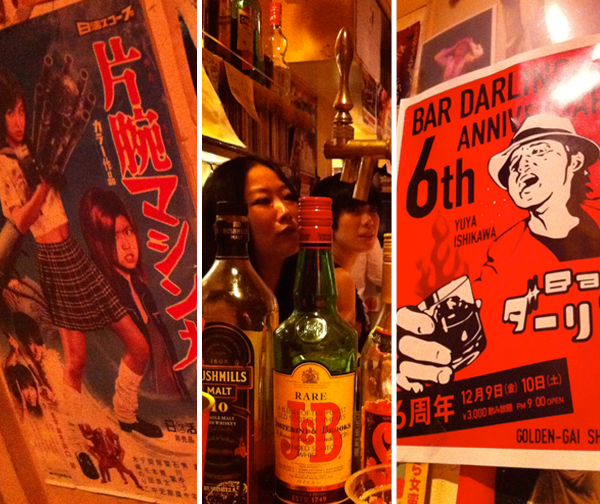
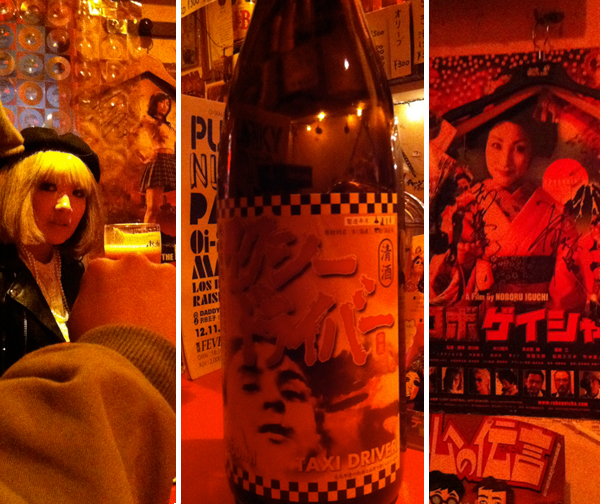
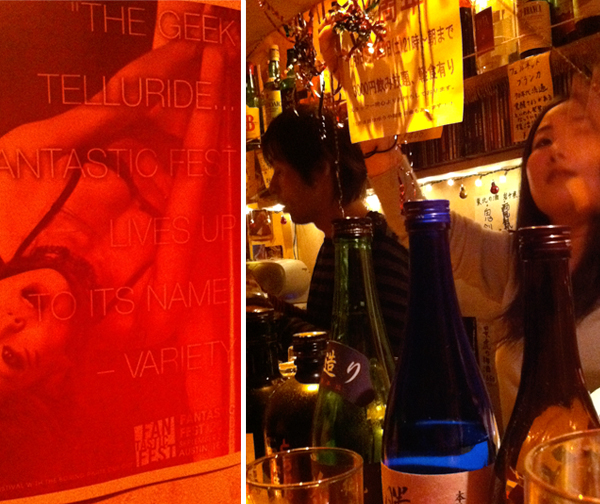


On my recent trip to Tokyo, I saw three indie bands with slightly funny-sounding names over three consecutive nights. J-Pop megagroups likeAKB48 (and their “warring” sister factions SKE48 and badass Kansai-basedNMB48) may blanket airwaves and adverts, but the indie scene is a-boomin'. I learn something new each time I attend a Tokyo indie-rock show. Considering these three were back-to-back, I learned a lot. Here's some of that!
* Who the Bitch: everyone gets to mosh, if you want to! Two riot-grrrls and a dude resembling an extra from Nagasaki jet-rockers Guitar Wolf playing punchy pop-punk. The crowd had been circle-pitting nonstop when the band launched into riff-heavy 「ベクトル」 (uh: “Vector”?), guitarist Ehi crooning “come back to me in my bed” (in English!). Want some of the action? The big crowd-control dude moshing along will see to it you get your moment of stage-diving fame. Don't want to? Cross your arms NYC-style, and even the wildest kids will politely avoid crashing into you.
* 住所不定無職: ease back on taking photos and just have fun! These vintage clothing-coordinated indie-pop girls met at the unemployment office, hence the translation of their name: “no job nor fixed address”. I was up front and right-of-center to photograph cutie Yoko, co-vocalist and player of a glittering double-neck bass/guitar—but I held off. I alluded in my previous Tokyo indie-rock post that photography is generally verboten. How refreshing to just experience their upbeat, singalong anthems without studying an iPhone screen!
(speaking of Guitar Wolf: they headlined this show, and I've never seen so many white people at a Tokyo indie show before. Guess how many were taking photos!)
* Plastic Girl in Closet: Japanese shoegaze rules! J-Pop may rule, but the Japanese do some mighty fine—and ferociously loud—shoegaze. The adorable four-piece Plastic Girl in Closet celebrated their third LP ekubo(“dimple”, a nod to their twee-ness) with their first-ever “one-man show”, ripping through their back catalogue for nearly two hours of sonic bliss. That the long-delayed My Bloody Valentine reissues coincided with this show felt particularly auspicious. For beyond the guitar squalls and ethereal vox, it was Ayako's muscular basslines that really shined, up there with MBV's Debbie Googe.
* reserving tickets: perhaps it's thanks to these bands' indie-ness, but each offers to reserve advance tickets, so long as you email them. You still have to pay, but at least you've secured a spot in one of Tokyo's “cozy” 100-person capacity live-houses.
Image collage: (clockwise from top) courtesy 住所不定無職, Plastic Girl in Closet, Who the Bitch




Bookstores seem to be thriving in Tokyo. I can't walk two blocks in any direction without seeing the cheery character for book, “本”. Those searching for the rare vintage edition or secondhand paperback get their fix in Jimbochō. This neighborhood lines one broad avenue (plus myriad side streets and back alleys) with tons of used-book shops. And as this is Japan, it's all about specialization, with paperback “general stores” outnumbered by closet-sized nooks crammed with French classics, music magazines, and hairspray-heavy '80s porn.
Kanda Kosho Center (named both for the Chiyoda Ward district and for the literal translation of used books, kosho) is Jimbochō's used-book gateway, nine floors of categorized havens kitty-corner from the train station. The handy placard posted adjacent to Kanda Kosho's lifts is of no use if you don't read Japanese, but no worries: poke your head into a shop, and even the skeeziest porn joint's owner won't give you a passing glance.
Want a three-volume set of The Fishes of the Japanese Archipelago, back-issues of Japanese-language rugby magazines (who knew??), or a monthly periodical pointedly titled Gun? Those can be had on the third and fourth floors, respectively. Miwa, the all-kids bookstore on 5, features Golden Books from an alternative universe, like “Oden-kun”, whose titular hero is an anamorphic daikon radish. Beyond the wonderful jazz and classical record shop crowning Kanda Kosho, the upper floors all house unrelated porn shops, their otherwise muted environs punctuated by the sharp crackle of individually-sealed plastic wrappers, as customers dutifully pull out and shove back periodicals like Cream and Scholar from overstuffed shelves.
Let's say you didn't find that specific skin-mag you so desired. You're totally in luck! A brief jaunt off Jimbochō's mainstream is Aratama Total Visual Shop (the “visual”, written in English, is a clue they sell lots of nude stuff) and its mirror-façaded, younger kindred. The latter is stocked almost entirely with bondage and fetish magazines, which surprised even this intrepid reporter in their diversity. Aratama the elder contains an encyclopedic array of AV photo-books and PG-13 gravure mags, but its achievement is a whole room of posters and life-sized cardboard cutouts of cuties. The addition of sealed, autographed photographs of various models (going for like $150-400 per 4x6” print) feels almost superfluous.
I can spend hours in Shinjuku East's Kinokuniya, the ferroconcrete bookstore behemoth that makes its shiny Manhattan cousin feel absolutely puny by comparison. But for those treasured and unique—yes, sometimes very deviant—finds, Jimbochō is the only destination.
Images: courtesy the author

Are you as pissed as I am about the impending arrival of 100+ 7-Eleven stores and the Big Bite they will chomp out of Manhattan's bodega community? Yesterday, my Black Balloon colleague Jake reminisced on the homely bodega's many high points. I feel you, Jake, but let me just say one thing: if this were actually an invasion of sebun-irebun, the cheery kombini(convenience store) chain owned by Japan's Seven & I Holdings Co....now that might not be so bad.
Just think: spotless, well-lit, one-stop destinations for sustenance, banking, even package shipment and receiving.
I'm heading to Tokyo next month. Most of my money will go toward concert tickets and fetish bars, so I have willingly resigned myself to “dining” at 7-Eleven at least half the time. Meaning a tallboy of Suntory and a transcendent katsu-sando (breaded, deep-fried pork cutlet and sauce on springy, crustless white bread) for 500 yen, or approximately $6. Breakfast—or whatever—of champions.
Of course, to make these 7-Elevens truly authentic, they would need to beam in a Japanese staff. The super-polite kind who will inquire if you want that curry pan microwaved, and who won't get on your ass if you loiter in the store for three hours, soaking up free WiFi and paging through phonebook-sized manga journals with busty gravure idols on the cover. Yeah, not gonna happen.
Then again, “Big Gulp” doesn't exist in the Japanese vernacular—let alone “Big Bite.” So a proper sebun-irebun in the Big Apple? Fuhgettaboutit.
Image: Ragamuffinsoul (Big Gulp) and Wikipedia (katsu-sando), photo-chopped by the author.

Ever since relocating to Austin last summer, I'd kept one eye on the live-music/film-premiere/interactive behemoth South By Southwest. This year was to be my first, and as a veteran of CMJ Music Marathon and a pioneer at Brooklyn's first-ever Northside Festival, I was beyond stoked. But between work trips to NYC and Tokyo, culminating in a three-week sojourn to the Big Apple this past month, time slipped by. On my late-night flight back to Austin last Wednesday, surrounded by skinny blokes with guitar cases and European accents, I realized—Oh snap, South By Southwest!
I had to attack this beast badgeless and wristbandless, with a major NYC hangover and little schedule in mind besides what I'd culled fromBrooklynVegan and various Facebook invites. Luckily, Japanese art-punksPeelander-Z were hosting a free day-show of caffeinated awesomeness called “Peelander-Fest.” It featured a solid mix of Japanese acts (like the Motörhead-ish Electric Eel Shock) and yanks, topped by a sweaty Peelander-Z set, in 20-minute bites.
Free show? Cheap booze? Japanese bands? Sign me up!
I bussed to the Grackle, an East Austin dive bar and gravel lot that echoed Jelly NYC's Saturdays @ Rock Yard, except the latter had a slip-n-slide and Williamsburg hipster girls and the Grackle better beer and tattoos.
Lagitagida, self-described as “a super-powered attack instrumental rock band,” played as fast as Brooklyn black-metalheads Liturgy but with way less austerity. At least Lagitagida were having a shit-ton of fun. Next up was bicoastal (i.e. Tokyo/Brooklyn) duo Ken South Rock, who I re-dub KEN the Brotherhood, for beyond Kenichi and Adam's stripped-down sound, these “long-lost brothers” carried that charisma of their country-fried Nashville kin,JEFF the Brotherhood.
I refueled on lengua tacos when local noise-punks Black Cock went on (anybody remember Whale's “Hobo Humpin' Slobo Babe”? They're a bit like that), and met the Japanese. Despite the boozy, sun-baked environs, I did that whole two-handed name-card exchange with Lagitagida guitarist Kohhan and bassist Take. New drink buddies for my May trip back to ol' Nippon.
Sendagaya duo Gagakirise are succinctly summed up by their 2009 CD title:Black Long Hair Nice Wah Pedal.
Sets went precisely as scheduled, thanks to Kengo “Peelander-Yellow” Hioki's programming. This is something I noted in Tokyo: bands on and off almost exactly on time, even the ultra-DIY stuff, so I knew how much time I had before elbowing up front for Electric Eel Shock. These cock-rockers brought the house down. Frontman Akihiro may have playfully dissed punk at one point—“We're metal!!!!”—but, considering his flying riffs, bassist Kazuto's mastery of shout-and-response, and drummer Gian's instant denuding (except for a strategic sock), it was all love.
Sunburnt and smashed, thus concluded my first SXSW.
Image: Gagakirise, courtesy the author.

December, 2011: Fresh off two flights totaling 14 hours, I hit the streets of Tokyo. The thrilling all-female band TsushiMaMire had scheduled a one-off ahead of their big 2012 tour, at a stupidly named but promisingly chic Shibuya venue called clubasia. I'd met these riot grrrls at Santos Party House, and I was aching to catch them again on their home turf. So I did what any ballsy foreigner would do: I emailed them, including a brief message how we'd met in New York and that I'd be in town. Mari, the ballistically cute, ferocious singer/guitarist, immediately wrote me back, all excited. I was in.
Tickets to Tokyo rock shows cost up to 30 American smackers, which is likeTerminal 5 prices for a dude used to dropping $7 for an absolutely bonkers night at Death By Audio. But remember: this is Tokyo, where a Starbucks double espresso goes for $7. Luckily, most tickets factor in a one-drink pass, and drinking at Tokyo live music venues is good, from the smoothest draft beer to the surprisingly ubiquitous Zima.
Photography at shows is generally discouraged, and while you won't be ram-jammed for having your iPhone out, you also won't see people paying more attention to their smartphones than the band. What you can do is smoke cigarettes, so sensitive types should consider donning the ubiquitous "surgical" face-mask.
Locals can reserve tickets online via Lawson Ticket or EPlus and pick them up at their neighborhood 7-Eleven, which is awesome. But for us live-music freaks without local permanent addresses, that's a no-go. Bummer: after all those plane-hours getting stoked about bands, I wanted some guarantee that I'd get in. Good thing I'd sent that email.
On my way to the show, I traversed the rolling avenues of Love Hotel Hill in Dogenzaka, Shibuya. Picture gaudy-ass façades, pink neon and sex advertseverywhere. As Mari had reserved my ticket, I queued up opposite the physical-tickets group, which I noticed was assembled in "waves": like 1 to 4, similar to boarding an aircraft. Outside clubasia's stage room, I noted coin-lockers lining the corridor, where one could stash gear for a 300-yen fee. The importance of these lockers became very clear to me moments later, when the show erupted.
The floor was two-thirds the size of Music Hall of Williamsburg, including elevated stage, and everyone in the first three rows was decked in TsushiMaMire merch: t-shirts, multicolored scarf-towels, buttons, that jazz. I got to know my neighbors, like this reed-thin young dude who was stoked to see TsushiMaMire for the first time, these two cute girls, and this young salaryman-type, still wearing his suit and tie. Then TsushiMaMire ripped into their set…and I found myself slam-dancing. Yes: the front-row types were the hardcore fans, throwing up heavy metal horns in unison, hollering on cue to Mari's riffs, and moshing up a frenzy.
OK, I thought, boosting up the reed-thin dude so he could crowd surf, that'swhy the coin-lockers.
Image: courtesy the author



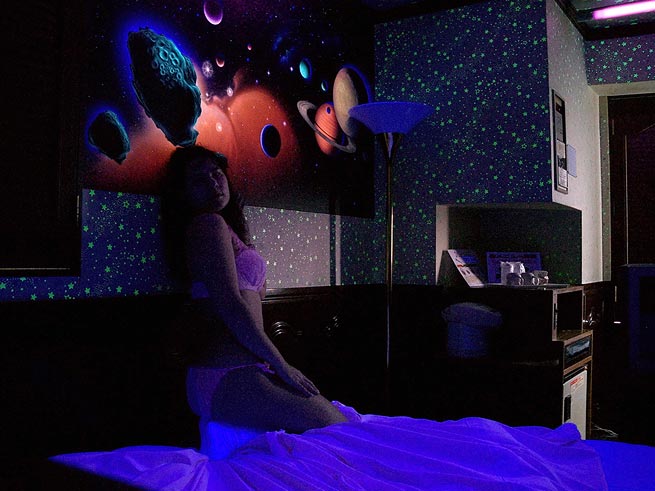




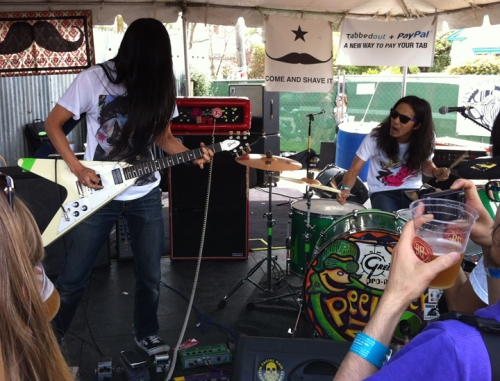
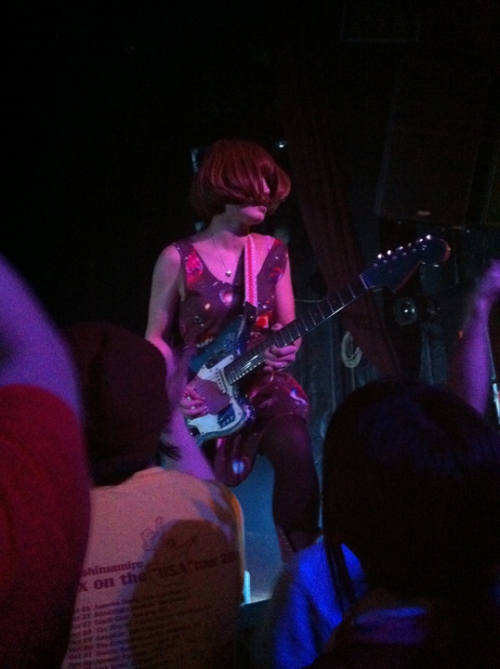



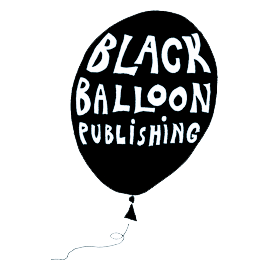 A Black Balloon Publication ©
A Black Balloon Publication ©